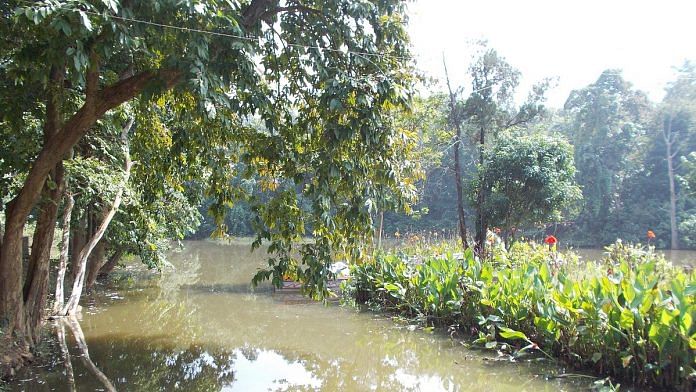I think of the plateau’s forests in the singular because they are connected, even if separated physically by roads, railways and rivers, and notionally by the forest department boundaries. The forest itself does not follow a uniform code.
On the highland, it starts as scrub, followed by the open sal forest with low undergrowth. In the moist, valley regions, it grows into a mixed woodland. The more sheltered the forest gets, the more depth it acquires. It grows denser along the slopes of the escarpment.
Before the plateau merges with the lower country below, the rivers begin to negotiate their width with the hills. The water system becomes richer and nuanced, supporting a variety of life besides the tall sal trees.
Wading into this forest is a task. The feet need to be careful and precise, hands aware of thorns on the twigs. Cuts and gashes are more frequent here. Us humans occupy the higher and the lower spaces, everything in between is the forest.
Elephants arrive too.
Also Read: A peek into Jharkhand’s mica mines where child labour & illegal mining are no secret
The herd enters from the south-west in Barkagaon. It then moves along the foot of the plateau towards Charhi. If they are conscious of the forest and do not stray, they pass. If they lose the cover, they are found fallen in coal mines. Sometimes, unbeknownst to elephants, the forest shrinks, and they return the next year to find themselves in the open. Sometimes, development happens, and they return the next year to find their green corridor replaced by a railway track.
From Charhi, the herd keeps to the forest and reaches Gomia. When the elephants march out, they follow the forest of the Konar basin, finding shelter in the northern and eastern escarpments. Here the herd branches out.
The first group takes the forest straight to Bagodar, while the second makes a detour. It travels up the elevation and skirts round Jhumra Pahad. Following a narrow strip of forest, it crosses NH 100 at Banhe and arrives near the villages of Khaira and Simradabh. These villages mark the end of the highland. When the elephants leave the plateau, they emerge on the Grand Trunk Road at Gorhar, from where they travel northwards to Chalkusha.
Elephants normally do not come up to the town, but in 2013, a lost herd had somehow strayed into the Canary Hill forest. Work on the new road had not started then. I was studying in Delhi. I read later on the internet that they found their way out through Jabra forest, but not before damaging a portion of Gibraltar.
Against the assault of rapid urbanization and the resulting loss of the plateau’s forest cover, there exists a pause twenty kilometres from the town. It appears as an uninterrupted stretch of woodland. We call it the ‘national park’.
Also Read: Indian forests out of space for more tigers. What will tiger lobby do now?
Hazaribagh National Park is a misnomer. The place is a myth. It does not exist, it has never legally existed.
In 1955, an impassioned plan was made by the forest officer, SP Shahi, to turn this stretch of forest into a national park, but his efforts did not yield a legal notification. From 1955 to 1976, it was a national park with no official backing.
In his essay ‘Battling for Wildlife in Bihar’, which appears in Valmik Thapar’s anthology Saving Wild Tigers, Shahi recounts the frustrating and often hilarious workings of the bureaucracy at Bihar’s forest department. It was the corrupt system, flavoured with a chain of short-lived governments and garnished liberally with a series of administrative mood-swings that posed the gravest challenge to procuring an executive order for the forest.
For twenty years the woods were a national park. For twenty years, they were not. The forest road was ready, the pamphlets advertised the tract as a national park, the tourists came and went away. All of this happened while the file was pushed from one forest minister to the next.
Finally, in 1976, the forest was notified as a wildlife sanctuary, this time with legal backing, and this is what the jungle is today.
Fiction and fact create a variegated system of knowledge.
Because in its initial decades, the forest was known as a national park, the phrase has quietly seeped into the town’s vocabulary too. It now occupies a respected spot in Hazaribagh’s list of tourist attractions. The place’s imagination is incomplete without its national park.
It does not matter that the forest is officially a sanctuary, and that national parks are, technically, different legal entities. The enduring idea of this forest as a national park is so strong that the phrase Hazaribagh Wildlife Sanctuary appears only on the entry gates. ‘Tell the truth but tell it slant,’ said Emily Dickinson. The forest still is a national park for us. There is even a Wikipedia page for this fine work of mythology.
 This excerpt from ‘Tales of Hazaribagh: An intimate exploration of Chhotanagpur Plateau’ by Mihir Vatsa has been published with permission from Speaking Tiger Books.
This excerpt from ‘Tales of Hazaribagh: An intimate exploration of Chhotanagpur Plateau’ by Mihir Vatsa has been published with permission from Speaking Tiger Books.



